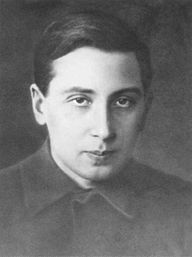- Oleg Lósev
-
Oleg Vladimírovich Lósev
Олег Владимирович Лосев
Nacimiento 10 de mayo de 1903
Tver, RusiaFallecimiento 22 de enero de 1942
San Petersburgo, RusiaNacionalidad Rusia, URSS Campo Física, ingeniería eléctrica Instituciones Laboratorio de Radio Nizhni-Nóvgorod (NRL), Central Radio Laboratory (TSRL, Leningrado), Leningrado Instituto Fisicotécnico, Primer Instituto Médico de Leningrado Oleg Vladimírovich Lósev (ruso: Олег Владимирович Лосев)( * 10 de mayo de 1903 - 22 de enero de 1942),[1] [2] ) fue un científico e inventor ruso.
Biografía
Nacido en una familia de clase alta en la Rusia Imperial, sirvió como capitán en el ejército zarista.
Publicó una serie de artículos y patentes durante su corta carrera.
Sus observaciones de los LED permanecieron inadvertidas durante medio siglo hasta ser reconocidos a finales del siglo XX y principios del XXI.
En el transcurso de sus trabajos como técnico de radio, advirtió que los semiconductores empleados en los receptores de radio emitían luz cuando una corriente eléctrica los atravesaba, este fenómeno ya había sido observado, independientemente años antes, por Henry Joseph Round.[3]
En 1927, Lósev publicó los detalles del primer diodo emisor de luz, en una revista científica rusa. En el período de 1924 a 1941, publicó una serie de artículos, detallando las funciones de un dispositivo, que él mismo había desarrollado, que generaba luz mediante electroluminiscencia, cuando los electrones emiten luz al caer a un nivel de energía inferior.
En abríl de 2007 en un artículo de Nature Photonics, Nikolay Zheludev da a conocer a Lósev como el inventor del LED.[4] [5] Específicamente, Lósev patentó el relé de luz "Light Relay"[6] y por ende su uso en la telecomunicaciones. Desafortunadamente, antes de que se pudiera desarrollar su invento, tuvo lugar la Segunda Guerra Mundial, y Lósev murió en 1942 durante el sitio de Leningrado (hoy San Petersburgo), a la edad de 39 años.
Enlaces externos
- Facsimil de "Light Relay" y otras patentes de Oleg Lósev — de blog de Patentes rusas
- Oleg Vladimirovich Losev 2004 - пионер полупроводниковой электроники. Физика твёрдого тела, 46, (1),5-9
- Radio a galena
- Kisilova
Notas y referencias
- ↑ [1] Física del Estado Sólido, 2004, Tomo 46, No. 1, "Un pionero de la electrónica de semiconductores" (en idioma ruso)
- ↑ [2] "пионер полупроводниковой электроники", English translation: Solid state physics, 2004, volume 46, iss. 1, "Oleg Vladimirovich Losev - Pioneer of the Semiconductor Electronics"
- ↑ H. J. Round (9 de febrero de 1907) "A note on carborundum," Electrical World, 49: 309
- ↑ Nikolay Zheludev. «The life and times of the LED — a 100-year history». Nature Photonics 1 (4): pp. 189-192. doi:. http://www.orc.soton.ac.uk/fileadmin/downloads/100_years_of_optoelectronics__2_.pdf.
- ↑ Tom. «The LED - older than we thought». NewScientist Blogs. Consultado el 11-04-2007.
- ↑ Soviet patent #12191 granted in 1929
Categorías:- Nacidos en 1903
- Fallecidos en 1942
- Físicos de Rusia
- Inventores de Rusia
Wikimedia foundation. 2010.
